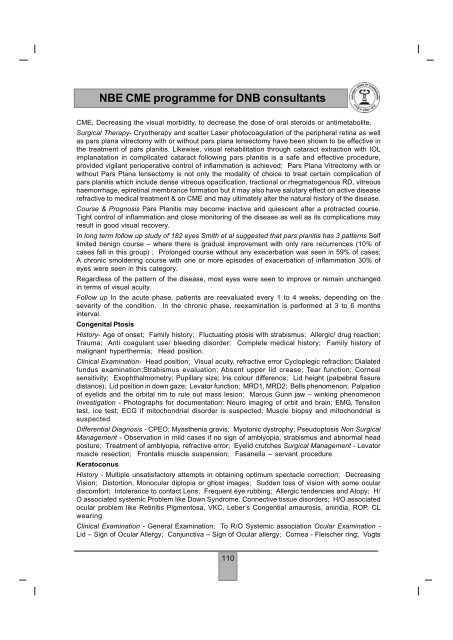NBE CME programme for DNB consultants - National Board Of ...
NBE CME programme for DNB consultants - National Board Of ...
NBE CME programme for DNB consultants - National Board Of ...
You also want an ePaper? Increase the reach of your titles
YUMPU automatically turns print PDFs into web optimized ePapers that Google loves.
<strong>NBE</strong> <strong>CME</strong> <strong>programme</strong> <strong>for</strong> <strong>DNB</strong> <strong>consultants</strong><strong>CME</strong>, Decreasing the visual morbidity, to decrease the dose of oral steroids or antimetabolite.Surgical Therapy- Cryotherapy and scatter Laser photocoagulation of the peripheral retina as wellas pars plana vitrectomy with or without pars plana lensectomy have been shown to be effective inthe treatment of pars planitis. Likewise, visual rehabilitation through cataract extraction with IOLimplanatation in complicated cataract following pars planitis is a safe and effective procedure,provided vigilant perioperative control of inflammation is achieved; Pars Plana Vitrectomy with orwithout Pars Plana lensectomy is not only the modality of choice to treat certain complication ofpars planitis which include dense vitreous opacification, tractional or rhegmatogenous RD, vitreoushaemorrhage, epiretinal membrance <strong>for</strong>mation but it may also have salutary effect on active diseaserefractive to medical treatment & on <strong>CME</strong> and may ultimately alter the natural history of the disease.Course & Prognosis Pars Planitis may become inactive and quiescent after a protracted course.Tight control of inflammation and close monitoring of the disease as well as its complications mayresult in good visual recovery.In long term follow up study of 182 eyes Smith et al suggested that pars planitis has 3 patterns Selflimited benign course – where there is gradual improvement with only rare recurrences (10% ofcases fall in this group) ; Prolonged course without any exacerbation was seen in 59% of cases;A chronic smoldering course with one or more episodes of exacerbation of inflammation 30% ofeyes were seen in this category.Regardless of the pattern of the disease, most eyes were seen to improve or remain unchangedin terms of visual acuity.Follow up In the acute phase, patients are reevaluated every 1 to 4 weeks, depending on theseverity of the condition. In the chronic phase, reexamination is per<strong>for</strong>med at 3 to 6 monthsinterval.Congenital PtosisHistory- Age of onset; Family history; Fluctuating ptosis with strabismus; Allergic/ drug reaction;Trauma; Anti coagulant use/ bleeding disorder; Complete medical history; Family history ofmalignant hyperthermia; Head position.Clinical Examination- Head position; Visual acuity, refractive error Cycloplegic refraction; Dialatedfundus examination;Strabismus evaluation; Absent upper lid crease; Tear function; Cornealsensitivity; Exophthalmometry; Pupillary size; Iris colour difference; Lid height (palpebral fissuredistance); Lid position in down gaze; Levator function; MRD1, MRD2; Bells phenomenon; Palpationof eyelids and the orbital rim to rule out mass lesion; Marcus Gunn jaw – winking phenomenonInvestigation - Photographs <strong>for</strong> documentation; Neuro imaging of orbit and brain; EMG, Tensilontest, ice test; ECG if mitochondrial disorder is suspected; Muscle biopsy and mitochondrial issuspectedDifferential Diagnosis - CPEO; Myasthenia gravis; Myotonic dystrophy; Pseudoptosis Non SurgicalManagement - Observation in mild cases if no sign of amblyopia, strabismus and abnormal headposture; Treatment of amblyopia, refractive error; Eyelid crutches Surgical Management - Levatormuscle resection; Frontalis muscle suspension; Fasanella – servant procedureKeratoconusHistory - Multiple unsatisfactory attempts in obtaining optimum spectacle correction; DecreasingVision; Distortion, Monocular diplopia or ghost images; Sudden loss of vision with some oculardiscom<strong>for</strong>t; Intolerance to contact Lens; Frequent eye rubbing; Allergic tendencies and Atopy; H/O associated systemic Problem like Down Syndrome, Connective tissue disorders; H/O associatedocular problem like Retinitis Pigmentosa, VKC, Leber’s Congential amaurosis, aniridia, ROP, CLwearingClinical Examination - General Examination; To R/O Systemic association Ocular Examination -Lid – Sign of Ocular Allergy; Conjunctiva – Sign of Ocular allergy; Cornea - Fleischer ring; Vogts110
















